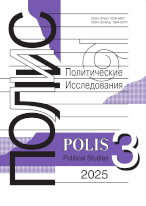China-Russia-US Relations and Strategic Triangles
Graham T.,
Yale University, New Haven, USA; Kissinger Associates, New York, USA, tgraham@cfr.org
DOI: 10.17976/jpps/2020.06.05
Graham T. China-Russia-US Relations and Strategic Triangles. – Polis. Political Studies. 2020. No. 6. https://doi.org/10.17976/jpps/2020.06.05
China, Russia, and the United States are the three most active geopolitical actors today. One central question is whether the three powers can replicate the American-Chinese-Soviet strategic triangle of the 1970s that refashioned the global geopolitical landscape. That earlier triangle emerged as a consequence of a U.S. policy decision to reestablish relations with China as part of a strategic design to enable the United States to exit the war in Vietnam “with honor,” restrain the Soviet Union’s burgeoning power, and stabilize East Asia. Through deft diplomacy, Washington advanced its goals, but the triangle endured for most of the 1970s because it also advanced Soviet and Chinese interests. Today, the return of great-power competition has sparked debate about the emergence of a new strategic triangle. One does not now exist, primarily because the United States is not interested in establishing a working link with Russia. Because Washington does not believe that Russia adds much to the challenge it faces from China alone, it is unwilling to do much to disrupt growing Russian-Chinese alignment. Whether a strategic triangle comes into being depends largely on Russia. It has to convince both Washington and Beijing that its policy choices can significantly shift the balance between the two now and in the future. Neither capital believes that now, largely because they doubt Moscow’s ability to revitalize the economy to generate the resources it needs to back up its great-power ambitions in the long run.
References
Allison G. 2018. China and Russia: A Strategic Alliance in the Making. – The National Interest. URL: https://nationalinterest.org/feature/china-and-russia-strategic-alliance-making-38727 (accessed 13.10.2020).
Dominguez-Jimenez M., Poitiers N. 2020. FDI another day: Russian reliance on European investment. Policy Contribution 03/2020. Bruegel. URL: https://www.bruegel.org/wp-content/uploads/2020/02/PC-03_2020_-1.pdf (accessed 13.10.2020).
Ford C.A. 2020. Competitive Strategy vis-a-vis China and Russia: A View from the “T” Suite. – Arms Control and International Security Papers. Vol. 1. No. 6. URL: https://www.state.gov/wp-content/uploads/2020/06/T-paper-series-6-Strategic-competition-508.pdf (accessed 13.10.2020).
Kissinger H. 1979. White House Years. Boston: Little, Brown and Company.
Nabil R. 2020. Evaluating Russia’s Pivot to Asia. – Yale Journal of International Affairs. Vol. 15. P. 16-43.
Karaganov S. 2020. The Future of the Big Triangle. – Russia in Global Affairs. (In Russ.) URL: https://globalaffairs.ru/articles/budushhee-bolshogo-treugolnika/ (accessed 13.10.2020).
See also:
Rutland P.,
Russia and China: Saga of Two Transitions to Market Economy. – Polis. Political Studies. 2009. No3
Khatuntzev S.V.,
The West and the “Eurasian Quadriga” (Russia, China, India, Iran). – Polis. Political Studies. 2015. No6
Lukin A.V.,
Russia and China in Greater Eurasia. – Polis. Political Studies. 2020. No5
Utkin A.I.,
Energy resources and geopolitics. – Polis. Political Studies. 2010. No3
Isayev B.A.,
Geopolitics: classical and modern. – Polis. Political Studies. 2011. No2





.jpg)






 print
print
.jpg)
.jpg)